
OR
Opinion
A Mature Relationship: Nepal and the US at 75
Published On: June 11, 2022 02:30 PM NPT By: Dinesh Bhattarai
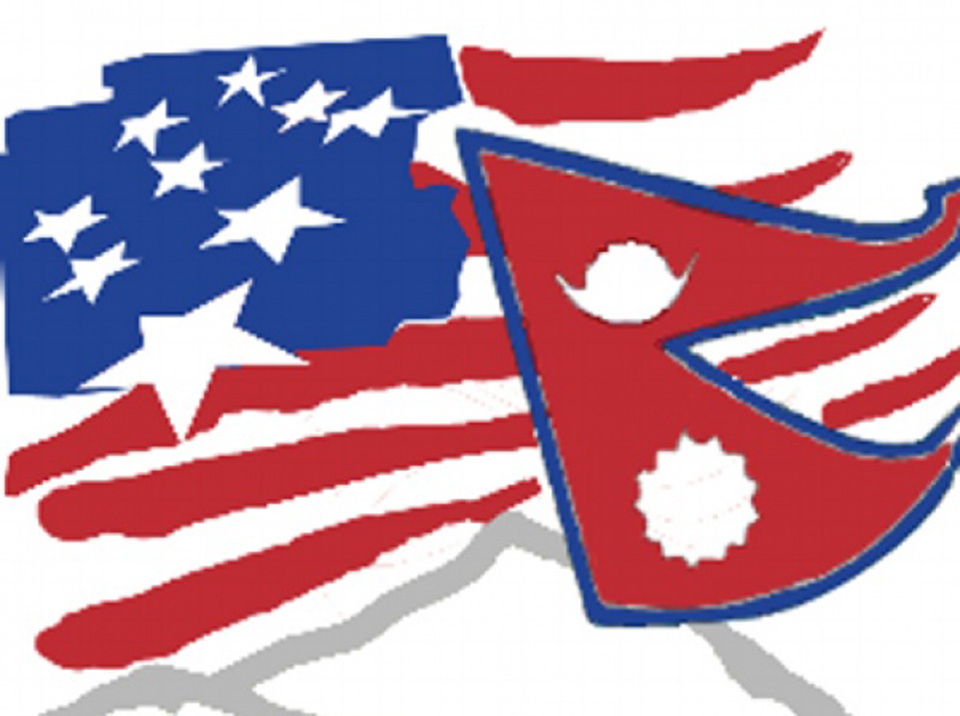
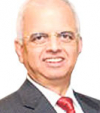
Dinesh Bhattarai
Dinesh Bhattarai, former diplomat and foreign policy expert, has served as the foreign affairs adviser of former prime ministers Sher Bahadur Deuba and Sushil Koirala.news@myrepublica.com
Relations between Kathmandu and Washington over the past seven decades have grown steadily covering a wide range of cooperation. The exchange of visits at senior officials’ level has been a regular feature in the bilateral relation.
On April 25, 1947, Nepal and the United States of America signed the Agreement of Commerce and Friendship and established diplomatic relations. The USA is the second and one of the four countries among the United Kingdom, India and France to have established diplomatic relations with Nepal before Nepal began its journey in the comity of democratic nations. In 1950-51, following the success of the popular revolution led by the Nepali Congress, Nepal broke isolationism in foreign policy and began its democratic and diplomatic journey. Nepal established its embassy in Washington on February 3, 1958. Similarly, the United States opened its embassy in Kathmandu on August 6, 1959. The relationship with the United States has been significant in Nepal’s foreign policy in diversifying its diplomatic relations and maintaining friendly and cooperative ties with all countries of the world.
The United States remains a superpower and maintains ‘strong and growing relationships across South Asia’ and desires to stay ‘actively and effectively engaged’ with the region. Washington remains engaged with every nation in the region as former Assistant Secretary of State for South Asian Affairs, Karl Inderfurth said, “each on its own merits — from Nepal in the north to Sri Lanka and the Maldives in the South, and everything in between.” The US recognizes South Asia as an increasingly dynamic region that is home to more than one-fifth of humanity and sees the future of South Asia and the United States as inevitably linked. American goals in the region are to help it “move forward firmly and irreversibly on paths to stability, democracy, moderation and prosperity.”
US policy toward Nepal appears to have been shaped by three fundamental objectives, i.e., a) support for peace and stability in South Asia, b) support for Nepal’s independence and territorial integrity, and c) support for one of the world’s least developed countries in its development efforts through selected programs of economic aid and technical assistance. Nepal’s stability and development are linked to order, peace, and security of South Asia in a broader aspect. US Ambassador to India, Ellsworth Bunker, then concurrently accredited to Nepal from India, also underlined the importance of Nepal’s independence as a “stone in the arch of world freedom and progress,” and added, “We, all freedom-loving countries, want to keep each stone in place, for each is as necessary and important as any other. To help Nepal make its contribution to that arch is reason enough for our assistance.”
Relations between Kathmandu and Washington over the past seven decades have grown steadily covering a wide range of cooperation. The exchange of visits at senior officials’ level has been a regular feature in the bilateral relation. Several Congressional delegations and Senior State Department officials have been visiting Nepal, but the visit at the highest level from the United States is yet to take place, hence long due. In this 75th year of the establishment of the diplomatic relation between Nepal and the United States, Prime Minister Sher Bahadur Deuba expects “more high-level engagements and economic partnership in the days to come.” Let’s hope exchange of visits at the highest levels will mark the 75th anniversary of the diplomatic relation.
Prime Minister Deuba participated in the Leaders’ Summit for Democracy hosted by US President Joe Biden in December last year and shared “Nepal’s experiences in the journey of democracy and democratic transformation.” He emphasized that only when democracy is able to meet the people’s economic aspirations and uplift their living standards, can it survive; hence, the importance of resource support by development partners is paramount. Only Nepal’s PM, India’s PM and the Maldives’s President were invited to the Democracy Summit from South Asia. The emphasis of the Summit was on democracy’s ability to deliver.
King Mahendra visited the USA on April 27-30, 1960, for the first time. He addressed the joint session of the US Congress on April 28, 1960. The second time the king visited Washington was on November 1-3, 1967. Prime Minister BP Koirala had a meeting with US President Dwight Eisenhower on the sidelines of the United Nations General Assembly on September 22, 1960, in New York. The President shared the Prime Minister’s argument about the “force of the public opinion,” in governance and the need for development to sustain the process of democratization.
King Birendra visited the United States in 1983. Welcoming the King, President Ronald Reagan described Nepal “as a neighbor on the other side of the world and said that he was pleased over the visit.” He added the visit “will serve to expand the goodwill between our peoples.” President Reagan said, “both Nepal and the United States, despite the distance separating them, enjoyed a particularly amicable relationship.” He then extended American support to Nepal in the Zone of Peace Proposal initiated by King Birendra and expressed his hope that “one day the world in its entirety would become a Zone of Peace.” President Reagan advised “Nepal should work closely with her neighbors to make the Peace Zone proposal a reality.” (Italics are mine) Former Secretary of State Henry Kissinger, in a brief encounter with the Nepali press after he met the King during his US visit, said that for Nepal “being surrounded by great powers, a little country between two elephants, it is important to have a Zone of Peace.” US first lady Hillary Clinton visited Nepal in 1995. Both the countries agreed to strengthen bilateral relations. Prime Minister Sher Bahadur Deuba visited the United States from May 6-11, 2002 and had a meeting with President George W Bush at the Oval Office.
US Secretary of State Colin Powell visited Nepal in January 2002 when the Maoist armed conflict was at its peak. He recognized the Nepali government's right to protect its citizens and institutions from terrorist attacks and expressed US’s commitment to aid Nepal’s development. Powell expressed his admiration for Nepal’s strong tradition of tolerance and respect in a multiethnic, multicultural society, calling it “a model for us all.” He pledged continued US support for “helping the people of Nepal on the continuing path of development.” In a press conference held on January 18, 2002, in Kathmandu, Prime Minister Deuba termed Powell’s visit as “historic” and “a reflection of the excellent relations between Nepal and the United States of America.”
Former President Jimmy Carter visited Nepal in 1984 in an individual capacity and came to Nepal in 2007-08 as the Chief of the Carter Center when Nepal was making a democratic transition following the mainstreaming of Maoist rebels into the peaceful democratic and constitutional process. In 2017, an eight-member bipartisan Congressional delegation led by the US House of Representatives leader Nancy Pelosi was on a visit to Kathmandu. Foreign Minister Pradeep Kumar Gyawali visited Washington from December 18-20, 2018 and had a meeting with his counterpart Michael Pompeo. Congressman Ami Bera, who chaired the House Foreign Affairs Committee‘s subcommittee on Asia, the Pacific and Nonproliferation, came to Nepal leading a four-member bipartisan Congressional delegation in February 2020.
US Senator Kirsten Gillibrand led a delegation consisting of US Senators Cory Booker and Mark Kelly and Representative Mondaire Jones of the US Congress (the House of Representatives ) visited Nepal in April this year. The visit of the Congressional delegation coinciding with the 75th anniversary of the establishment of diplomatic relations was to further strengthen the bilateral ties in this “period of heightened global tension.” The delegation had meetings with Prime Minister Deuba and Foreign Minister Narayan Khadka and also with members of the parliament. After the meeting, the Prime Minister tweeted that there was an exchange of views on Nepal-US friendship and ways for enhancing multifaceted partnership involving governments, parliaments, and people in general. The meeting also discussed global issues such as climate change. The delegation discussed with foreign minister Narayan Khadka for expanding bilateral cooperation in various areas including economic development and shared views on areas of common interests at bilateral and multilateral levels. The Ministry of Foreign Affairs in its press release said that “matters related to agriculture and food security as well as Nepal’s role in the UN peacekeeping also featured during the conversation.” “Both sides,” the press release said, “underscored the importance of parliamentary interactions for the enrichment of the multidimensional Nepal-US friendship.”
The delegation offered US cooperation in institutionalizing democracy and in the field of climate change and poverty alleviation. They also thanked the government and political leaders of Nepal for the ratification of the Millennium Challenge Corporation Nepal Compact and acceptance of a $659 million (Rs. 79.71 billion) grant through the United States Agency for International Aid Agency (US AID). Nepal’s government thanked the US government and the American people for their continued support including during the difficult times of the 2015 earthquakes and the recent COVID-19 pandemic. Media reports speak of the delegation raising their concerns about the Tibetan refugees and their identification.
The US delegation also had a meeting with the Nepal-US parliamentary committee headed by MP Minendra Rijal, who conveyed to the delegation that “MCC was a very important resource for Nepal's infrastructure development and renewable energy,” and said, “the visiting US lawmakers expressed their commitment to continuing necessary assistance for Nepal's prosperity, livelihoods, and inclusive development.” The delegation commended and appreciated Nepal’s extremely professional contributions to international peace and security and courageous commitment on behalf of global peacekeeping operations around the world. The delegation assured the committee that the US would continue to provide necessary assistance for disaster management in Nepal.
Under Secretary of State for civilian security, democracy, and human rights and special coordinator for Tibetan issues, Uzra Zeya, made a three-day visit to Nepal in May 2022. The State Department press release said her visit to India and Nepal from May 17-22 was “to deepen cooperation on human rights and democratic governance goals, and to advance humanitarian priorities.” Under Secretary, Zeya had meetings with the Prime Minister, Foreign Minister, Home Minister, and government officials. She discussed Nepal-US relations, matters of mutual interest, bilateral ties, and cooperation at bilateral and multilateral forums. Nepal presented its domestic model of conflict resolution as an example for the world community.
The Home Minister thanked the US for resettling over 100,000 refugees from Bhutan in the United States and told her that Nepal’s position on Tibetan refugees has not changed over time. The Home Minister was reported to have told the visiting guest that “only Tibetan refugees who came to Nepal before 1989 were recognized as refugees by Nepal.” Despite not being a party to the 1951 Refugee Convention and its 1967 protocol, Nepal has been generous to provide shelter to fleeing refugees and practice the policy of ‘non-refoulement.’ “In Nepal,” the minister told the guest that “all refugees have equal access to health, education, facilities and vaccines against measles.” Zeya appreciated Nepal’s contribution to the field of religious freedom and human rights. She visited Tibetan refugees in Kathmandu which led to reactions both within and outside the country, particularly in China. In view of Nepal’s long-standing One China policy and geopolitical sensitivity, a Foreign Ministry spokesperson told the press that the US ambassador to Nepal was alerted not to visit Tibetan refugees.

US assistance in Nepal
US assistance began in 1951 and was instrumental in building infrastructures and launching socio-economic development of Nepal covering areas of transport, communication, public health, inclusive governance, sustainable economic growth, human capital and post-earthquake reconstruction and rebuilding among others. The US aided malaria eradication program brought malaria under control and made Nepal’s Terai good and safe for settlement, turning it into the ‘breadbasket.’ The aid from Washington has also infused capital, ideas and technology into Nepal helping its society and economy to enter into modernity.
The State Department website describes US’s relations with Nepal as “a strong and positive relationship.” It says “years of diplomacy, development, and military engagement have advanced U.S. interests as Nepal has evolved into a more peaceful, stable democracy with significant economic potential. Since the end of its 10-year civil war in 2006 and the devastating earthquakes of 2015, Nepal has successfully transitioned into a constitutional federal republic grounded in a constitution promulgated in 2015.”
The US has also offered its assistance to Nepal in fighting the COVID-19 pandemic. The American offer of $500 million under the Millennium Challenge Corporation Nepal Compact and yet another grant of $659 million (Rs. 79.71 billion) through the United States Agency for International Aid Agency (US AID) to Nepal are the largest ever grant assistance received from any country. The ratification of the MCC by the sovereign Parliament of Nepal testifies to the maturity of Nepal’s democracy. The contents of the compact were voluminously debated even at the grassroots level. Eventually, leaders of all political parties took the right call in the interest of Nepal’s development and the Nepal-US relationship. Non-ratification would have had adverse impacts far beyond. Democracy at times may appear noisy and ‘chaotic’ but it is only the democratic route that paves the way for every issue to its logical conclusion. PM Deuba’s cool-headed leadership and flawlessly consistent position vis a vis MCC should be acclaimed.
People to people contacts
People to people links have emerged as a dynamic element in Nepal-America relations. These links connect America and Nepal with each other more closely and in a comprehensive manner and create linkages in business, education, culture, migration, and tourism. The Nepali community in the US has been growing since the 1990s. American educational institutions provide opportunities for hundreds and thousands of Nepalese students and serve as significant centers for higher learning. Several scholarship programmes have facilitated Nepalis to the USA and American scholars to Nepal. IVP (International Visitors Programme) is yet another avenue that provides journalists, parliamentarians, government leaders, academics, civil society leaders for study tours of democratic institutions of the United States.
The shared commitment to democracy, rule of law, and human rights are common grounds that form the foundation of Nepal-US relations. Peace Corps volunteers serve cementing the bonds of friendship and understanding between Americans and the people of the countries they serve. The volunteers who worked under the Peace Corps in Nepal are in several influential positions in the United States- in legislature, executive branches of the government. They stand yet another source of links between the two countries and the peoples.
Extraordinary geopolitical shifts
The major portion of this seven decade was dominated by the Cold War, which ended in the collapse of the Soviet Union on December 26, 1991, followed by trends of globalization and explosion of state formation and state fragmentation. All these developments shifted alliances, demanding reordering national priorities and opening new opportunities for people. The post-Cold War era that had begun with the collapse of one structure - the Berlin Wall on November 9, 1989, ended with the collapse of another, the World Trade Center’s twin towers on September 11, 2001 in New York. ‘No one, apart from the few people who plotted and carried out these events, could have anticipated that they were going to happen. But from the moment they did happen, everyone acknowledged that everything has changed,’ wrote John Lewis Gaddis, a historian at Yale University. September 11 attacks were a wake-up call. These attacks injected a thinking in foreign and security policy that weak/fragile states pose acute risk to global security in an interdependent and interconnected world. A study conducted by the University of Maryland in 2005 in the United States says gravest danger to any nation lies in the weakness of other countries, which become staging grounds for terrorist attacks. This study mentions security gap, capacity gap and legitimacy gap as the features of weak, failing, and failed states. The US made it a foreign policy priority to address the consequences emanating from these states.
Nepal’s long-standing policy has been “friendship with all and enmity with none,” seeking goodwill, friendship, understanding, support and cooperation from its neighbors, friends and well-wishers in the international community. Of late, Nepal seems to be turning into a confluence of triangular interplay - American, Indian, and Chinese competition, and cooperation. In the ongoing geopolitical play of big powers, emerging global power China would try to push established global power America as far away from its borders as it could and reduce America's weight in international diplomacy. As China vigorously pursues peripheral diplomacy with ‘security, diplomacy and economics’ as its components, the US would try to influence China’s neighbors to contain and provide a counterweight to Chinese dominance. They would adopt whatever means they find convenient to advance their interests.
Nepal’s geostrategic location between India and China “forms the geopolitical heartland of Asia.” Geography is its destiny. The location explains its contemporary challenges. Nepal borders four of India’s politically sensitive states and China’s Tibet Autonomous Region which constitutes its “core concern” in its foreign policy. That makes its geographical location even more prominent in the context of rapidly shifting geopolitics. It is in the nature of every power that they would like to collect as much information as possible on social, political, and military climate and geopolitical developments. Nepal expects neighbors, friends and well-wishers in the international community not to cross any red lines that hurt its interests, destabilize the country or and deprive it of its legitimate aspirations. They all should understand that only an independent, stable, democratic, and prosperous Nepal will stand an anchor of regional stability and security. Nepal does not want any iota of ongoing US-China rivalry and competition, and India-China competition and tensions coming to its territory.
Nepal pursues democratic pluralism at home and multipolarity in international relations and judges every issue on its merits without fear or favor. Nepal has to do a tight rope walk and maintain the balancing behavior with all nations. There can be no question of Nepal choosing the side of any country. Nepal needs neighbors India and China as well as the US. It also needs the United Nations and friends in the international community. Nepal needs their goodwill, support, and cooperation for its socio-economic transformation. Nepal does not want any geostrategic maneuverings and counter-maneuverings against its neighbors and friends from its territory.
Nepal’s relations with its neighbors and the United States form an important element of its foreign policy. Nepal remains constructively engaged with neighbors, development partners and friends in the international community, on the basis of mutual respect and mutual benefits to advance its interests. These engagements are independent of each other. It is this policy that has made it possible for Nepal to maintain cordial and friendly relations with India, China, and the United States than they have with each other. Nepal takes different positions from that of the US, China and India in the United Nations on several issues that confront the world. Though geographically far apart, Nepal and the US present a model on how a superpower America and small and least developed country Nepal maintain the best of their relations with mutual respect and keep them growing for mutual benefit.
Nepal expects that its neighbors, friends and well-wishers in the international community should understand its increasing sensitivity of its geopolitical location and appreciate its long-standing position of the one-China policy and the age-old relations with China that have seen an upswing in recent years. We want them to appreciate that only a stable, democratic, peaceful, prosperous Nepal can be an anchor of regional peace, stability, and development. Nepal should develop a strategic culture for the skillful management of geostrategic sensitivity for the preservation of its sovereignty and protection of territorial integrity. It must not ignore the dynamic transformation that is generating a new set of strategic uncertainties and ambiguities in the neighborhood and beyond. This demands a pragmatic and realist approach to the conduct of foreign policy than the spurts of impulsive behavior triggered by immediate sentiments.
Geographically, a landlocked country of 29 million people in a world of about eight billion, situated far apart from the United States, located between two nuclear powers who are also rising economies and emerging global powers, Nepal’s location has acquired prominence. Never a colonized country, Nepalis are fiercely proud of their independence and sovereign status. Though a least developed country, and mired in political instability and interminable transition, Nepal does have a diplomatic profile commanding attention in terms of her contributions to the cause of world peace and security, role in the United Nations, strategic significance, commitment to the process of regional cooperation, tremendous water and natural resources endowments, as a model of harmony and tolerance in a huge diversity, people as the repository of the state power, economic importance of manpower etc. Given the strength and resources, a nation of Nepal's standing can do very little to mold the messy world in its image and interests. It fully understands that it has to work with neighbors, friends, and well-wishers to ensure that the currents of turbulent world change flow in the desired direction. Such efforts are best made in this age of highly interdependent and interconnected world, in cooperation and engagement with friends like the United States of America.
You May Like This
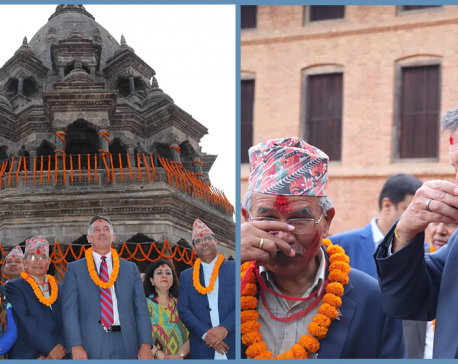
US Ambassador Berry tastes Aila and says, “It’s strong!”
A special ceremony was organized at Patan Durbar Square to mark the completion of the renovation of cultural artifacts in... Read More...
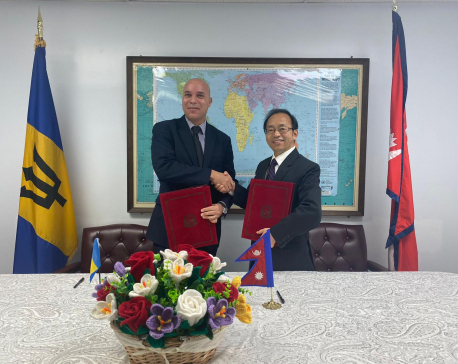
Nepal and Barbados establish diplomatic relations
KATHMANDU, Dec 9: Nepal and Barbados formally established diplomatic relations on Wednesday. With this, the number of countries with which... Read More...
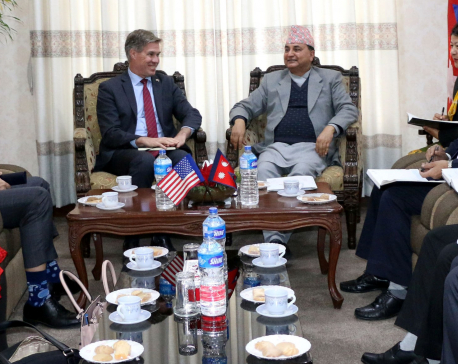
Legal complications likely to delay arms purchase from US
KATHMANDU, Feb 27: While the United States has been pushing Nepal on the procurement of thousands of M16 rifles as agreed... Read More...




Just In
- Govt receives 1,658 proposals for startup loans; Minimum of 50 points required for eligibility
- Unified Socialist leader Sodari appointed Sudurpaschim CM
- One Nepali dies in UAE flood
- Madhesh Province CM Yadav expands cabinet
- 12-hour OPD service at Damauli Hospital from Thursday
- Lawmaker Dr Sharma provides Rs 2 million to children's hospital
- BFIs' lending to private sector increases by only 4.3 percent to Rs 5.087 trillion in first eight months of current FY
- NEPSE nosedives 19.56 points; daily turnover falls to Rs 2.09 billion















Leave A Comment